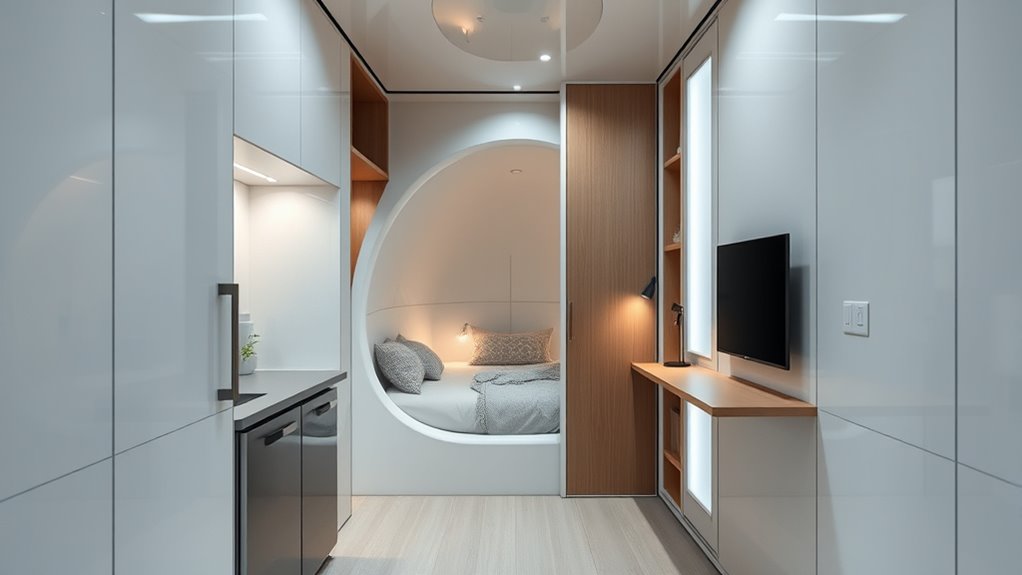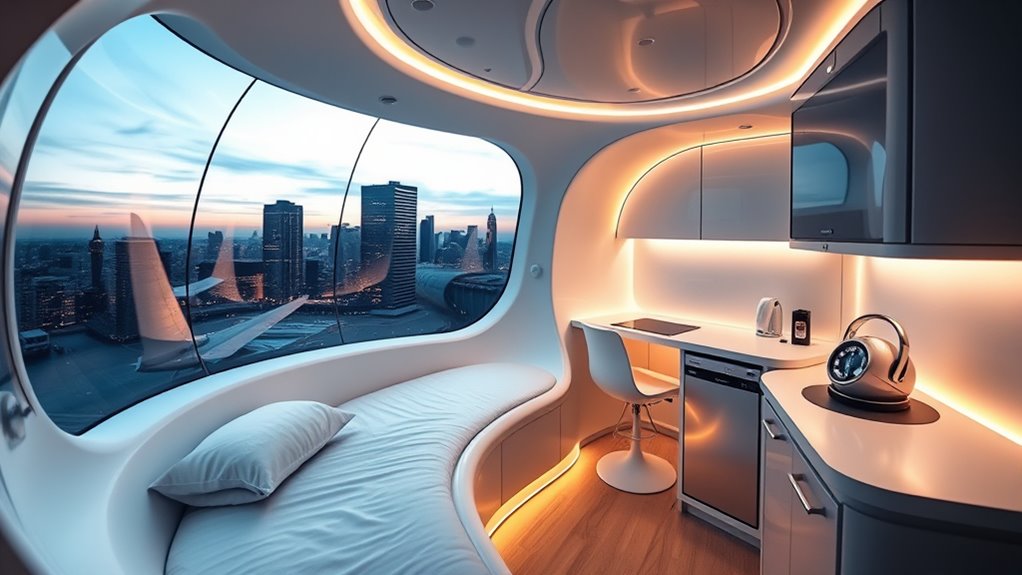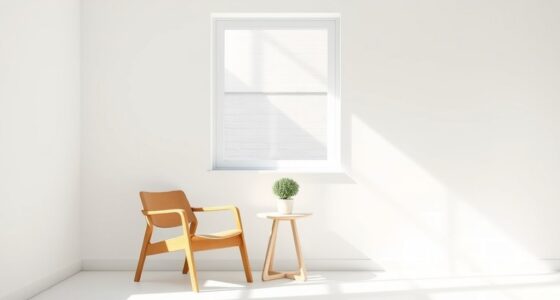To build a minimalist capsule home, focus on maximizing every room with space-saving, multi-functional furniture and a clutter-free approach. In the living area, choose modular or storage-integrated pieces and keep décor simple. In the kitchen, use compact appliances and wall-mounted racks, while bedrooms benefit from loft beds or built-in storage. Keep bathrooms streamlined with wall-mounted vanities. If you want to discover how to optimize each space for a cozy, open environment, there’s more to explore.
Key Takeaways
- Use multi-purpose, space-saving furniture like sofa beds and wall-mounted shelving to maximize small areas.
- Prioritize essential items and eliminate clutter to create a clean, open, minimalist environment in each room.
- Incorporate vertical storage solutions and built-in compartments to optimize space and reduce furniture footprint.
- Choose light colors and simple décor to reflect natural light and enhance the sense of spaciousness.
- Focus on functionality and quality over quantity, ensuring each piece adds purpose without overcrowding.

Have you ever wondered how to maximize small living spaces without sacrificing comfort? The key lies in embracing space saving furniture and minimalist design principles. When designing a capsule home, every inch counts, so choosing furniture that serves multiple purposes is essential. Think fold-away beds, wall-mounted desks, and modular storage units that tuck neatly into corners or under stairs. These pieces help you create a functional environment without clutter, giving your space a sleek, open feel. The goal is to eliminate unnecessary items and focus only on essentials, which is the foundation of minimalist design principles. Incorporating multi-functional furniture can dramatically enhance the versatility of your space.
Start room by room by prioritizing what you truly need. In a small living room, opt for a sofa bed or a compact loveseat that can double as a guest bed. Incorporate wall-mounted shelving instead of bulky cabinets to keep floors clear and make the room appear larger. When selecting furniture, look for pieces with built-in storage, such as ottomans with hidden compartments or coffee tables with drawers. By choosing space saving furniture, you free up room for movement and create a more airy atmosphere. Minimalist design principles emphasize clean lines, neutral colors, and clutter-free surfaces, so keep décor simple and intentional. Use light colors on walls and furniture to reflect natural light, making the space feel more expansive. Avoid over-accessorizing; instead, select a few meaningful decorative items that add personality without overwhelming the space.
Prioritize essentials, use multi-functional furniture, and embrace minimalist design to maximize small living spaces effortlessly.
In the kitchen, choose compact appliances and wall-mounted racks for pots and utensils to keep countertops clear. Small, versatile dining tables that can expand or fold away are perfect for a capsule home. In the bedroom, consider a platform bed with built-in drawers or a loft bed that frees up space underneath for a workspace or wardrobe. This approach not only maximizes storage but also maintains a minimalist aesthetic. Bathrooms benefit from wall-mounted vanities and shelves, which make the space feel less cramped. Keep toiletries and cleaning supplies organized and out of sight to preserve a clean, streamlined look.
Through careful selection of space saving furniture and adherence to minimalist design principles, you can transform a tiny space into a comfortable, functional home. The focus should always be on quality over quantity — choosing fewer, better pieces that enhance your lifestyle rather than clutter it. This mindful approach enables you to enjoy a streamlined, calming environment. When every piece serves a purpose and the overall design emphasizes simplicity and efficiency, your small space becomes a sanctuary that feels spacious, organized, and inviting.
Frequently Asked Questions
How Much Does a Capsule Home Typically Cost to Build?
A capsule home generally costs between $10,000 and $50,000 to build, making it an affordable housing option. Your costs depend on size, design, and materials used. Because of modular construction, you can often save money and time during build. You’ll find these tiny homes ideal for minimalist living, offering a compact, efficient space. Keep in mind, additional costs like land and permits are not included in this estimate.
What Are the Best Locations for Setting up a Capsule Home?
Imagine waking up to a new adventure every day—where’s the best place to set up your capsule home? Urban environments offer convenience, access, and vibrant city life, while rural settings provide tranquility, stunning nature, and space to breathe. Both locations hold unique allure, so think about what excites you most. Whether you crave the pulse of a city or the peace of the countryside, your perfect spot awaits.
Are There Any Zoning Restrictions for Tiny or Capsule Homes?
You should check local zoning laws and building codes before setting up your tiny or capsule home. Many areas have restrictions on minimum size, setbacks, and land use, which might limit where you can build. It’s essential to contact your city or county planning department to understand specific regulations. Knowing these rules helps you avoid legal issues and guarantees your minimalist space complies with all zoning laws and building codes.
How Do You Ensure Proper Insulation in Small Capsule Spaces?
To guarantee proper insulation in your small capsule space, focus on selecting high-quality insulation materials like spray foam, rigid foam boards, or mineral wool. These materials improve thermal efficiency by minimizing heat transfer. Seal all gaps and cracks thoroughly, especially around windows and doors, to prevent drafts. Regularly check and maintain insulation to keep your space comfortable year-round, maximizing energy efficiency and reducing heating or cooling costs.
What Are the Maintenance Requirements for a Capsule Home?
Think of your capsule home as a living organism that needs regular checkups. You should perform routine interior cleaning to keep it fresh and inviting, like giving it a breath of new life. Structural inspections are essential to catch any early signs of wear or damage, ensuring longevity. Keeping up with these maintenance tasks helps your small space stay functional, safe, and cozy, just like caring for a cherished companion.
Conclusion
Think of your capsule home as a tiny boat sailing smoothly through life’s storms. With each minimalist choice, you anchor yourself in simplicity, steering clear of chaos. Every room becomes a calm harbor, a safe haven you crafted with intention. As you navigate this vessel, you’ll find that less truly is more, guiding you toward clarity and peace. Embrace this journey, and let your minimalist space be the steady current that carries you forward.









